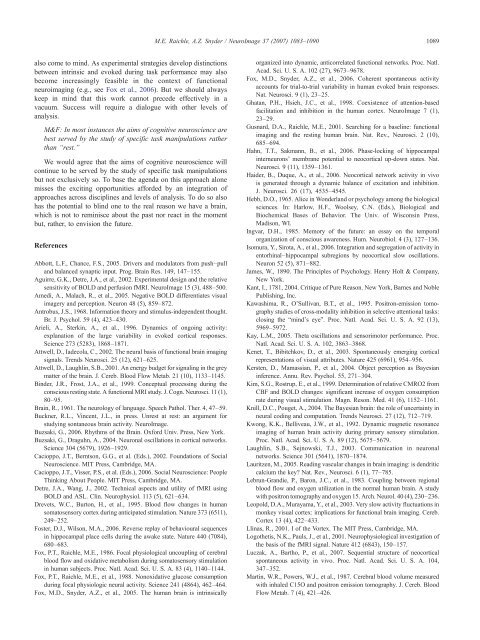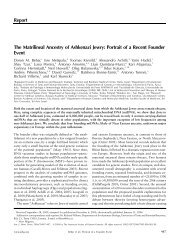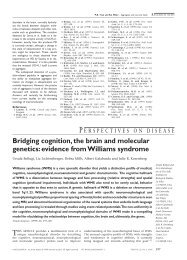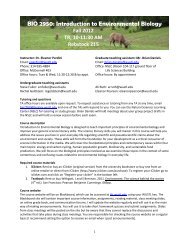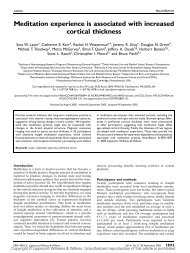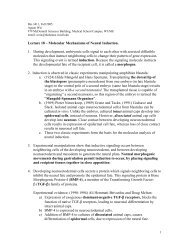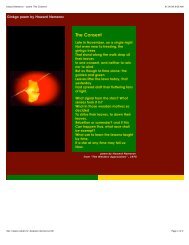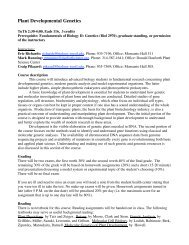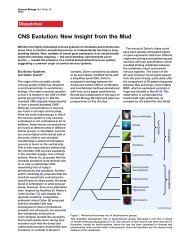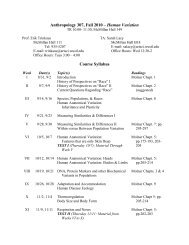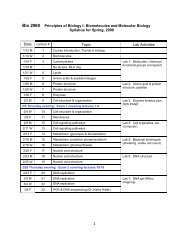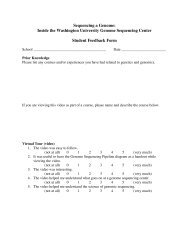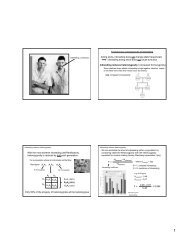A default mode of brain function: A brief history of an evolving idea
A default mode of brain function: A brief history of an evolving idea
A default mode of brain function: A brief history of an evolving idea
You also want an ePaper? Increase the reach of your titles
YUMPU automatically turns print PDFs into web optimized ePapers that Google loves.
M.E. Raichle, A.Z. Snyder / NeuroImage 37 (2007) 1083–10901089also come to mind. As experimental strategies develop distinctionsbetween intrinsic <strong>an</strong>d evoked during task perform<strong>an</strong>ce may alsobecome increasingly feasible in the context <strong>of</strong> <strong>function</strong>alneuroimaging (e.g., see Fox et al., 2006). But we should alwayskeep in mind that this work c<strong>an</strong>not precede effectively in avacuum. Success will require a dialogue with other levels <strong>of</strong><strong>an</strong>alysis.M&F: In most inst<strong>an</strong>ces the aims <strong>of</strong> cognitive neuroscience arebest served by the study <strong>of</strong> specific task m<strong>an</strong>ipulations ratherth<strong>an</strong> “rest.”We would agree that the aims <strong>of</strong> cognitive neuroscience willcontinue to be served by the study <strong>of</strong> specific task m<strong>an</strong>ipulationsbut not exclusively so. To base the agenda on this approach alonemisses the exciting opportunities afforded by <strong>an</strong> integration <strong>of</strong>approaches across disciplines <strong>an</strong>d levels <strong>of</strong> <strong>an</strong>alysis. To do so alsohas the potential to blind one to the real reason we have a <strong>brain</strong>,which is not to reminisce about the past nor react in the momentbut, rather, to envision the future.ReferencesAbbott, L.F., Ch<strong>an</strong>ce, F.S., 2005. Drivers <strong>an</strong>d modulators from push–pull<strong>an</strong>d bal<strong>an</strong>ced synaptic input. Prog. Brain Res. 149, 147–155.Aguirre, G.K., Detre, J.A., et al., 2002. Experimental design <strong>an</strong>d the relativesensitivity <strong>of</strong> BOLD <strong>an</strong>d perfusion fMRI. NeuroImage 15 (3), 488–500.Amedi, A., Malach, R., et al., 2005. Negative BOLD differentiates visualimagery <strong>an</strong>d perception. Neuron 48 (5), 859–872.Antrobus, J.S., 1968. Information theory <strong>an</strong>d stimulus-independent thought.Br. J. Psychol. 59 (4), 423–430.Arieli, A., Sterkin, A., et al., 1996. Dynamics <strong>of</strong> ongoing activity:expl<strong>an</strong>ation <strong>of</strong> the large variability in evoked cortical responses.Science 273 (5283), 1868–1871.Attwell, D., Iadecola, C., 2002. The neural basis <strong>of</strong> <strong>function</strong>al <strong>brain</strong> imagingsignals. Trends Neurosci. 25 (12), 621–625.Attwell, D., Laughlin, S.B., 2001. An energy budget for signaling in the greymatter <strong>of</strong> the <strong>brain</strong>. J. Cereb. Blood Flow Metab. 21 (10), 1133–1145.Binder, J.R., Frost, J.A., et al., 1999. Conceptual processing during theconscious resting state. A <strong>function</strong>al MRI study. J. Cogn. Neurosci. 11 (1),80–95.Brain, R., 1961. The neurology <strong>of</strong> l<strong>an</strong>guage. Speech Pathol. Ther. 4, 47–59.Buckner, R.L., Vincent, J.L., in press. Unrest at rest: <strong>an</strong> argument forstudying sont<strong>an</strong>eous <strong>brain</strong> activity. NeuroImage.Buzsaki, G., 2006. Rhythms <strong>of</strong> the Brain. Oxford Univ. Press, New York.Buzsaki, G., Draguhn, A., 2004. Neuronal oscillations in cortical networks.Science 304 (5679), 1926–1929.Cacioppo, J.T., Berntson, G.G., et al. (Eds.), 2002. Foundations <strong>of</strong> SocialNeuroscience. MIT Press, Cambridge, MA.Cacioppo, J.T., Visser, P.S., et al. (Eds.), 2006. Social Neuroscience: PeopleThinking About People. MIT Press, Cambridge, MA.Detre, J.A., W<strong>an</strong>g, J., 2002. Technical aspects <strong>an</strong>d utility <strong>of</strong> fMRI usingBOLD <strong>an</strong>d ASL. Clin. Neurophysiol. 113 (5), 621–634.Drevets, W.C., Burton, H., et al., 1995. Blood flow ch<strong>an</strong>ges in hum<strong>an</strong>somatosensory cortex during <strong>an</strong>ticipated stimulation. Nature 373 (6511),249–252.Foster, D.J., Wilson, M.A., 2006. Reverse replay <strong>of</strong> behavioural sequencesin hippocampal place cells during the awake state. Nature 440 (7084),680–683.Fox, P.T., Raichle, M.E., 1986. Focal physiological uncoupling <strong>of</strong> cerebralblood flow <strong>an</strong>d oxidative metabolism during somatosensory stimulationin hum<strong>an</strong> subjects. Proc. Natl. Acad. Sci. U. S. A. 83 (4), 1140–1144.Fox, P.T., Raichle, M.E., et al., 1988. Nonoxidative glucose consumptionduring focal physiologic neural activity. Science 241 (4864), 462–464.Fox, M.D., Snyder, A.Z., et al., 2005. The hum<strong>an</strong> <strong>brain</strong> is intrinsicallyorg<strong>an</strong>ized into dynamic, <strong>an</strong>ticorrelated <strong>function</strong>al networks. Proc. Natl.Acad. Sci. U. S. A. 102 (27), 9673–9678.Fox, M.D., Snyder, A.Z., et al., 2006. Coherent spont<strong>an</strong>eous activityaccounts for trial-to-trial variability in hum<strong>an</strong> evoked <strong>brain</strong> responses.Nat. Neurosci. 9 (1), 23–25.Ghat<strong>an</strong>, P.H., Hsieh, J.C., et al., 1998. Coexistence <strong>of</strong> attention-basedfacilitation <strong>an</strong>d inhibition in the hum<strong>an</strong> cortex. NeuroImage 7 (1),23–29.Gusnard, D.A., Raichle, M.E., 2001. Searching for a baseline: <strong>function</strong>alimaging <strong>an</strong>d the resting hum<strong>an</strong> <strong>brain</strong>. Nat. Rev., Neurosci. 2 (10),685–694.Hahn, T.T., Sakm<strong>an</strong>n, B., et al., 2006. Phase-locking <strong>of</strong> hippocampalinterneurons' membr<strong>an</strong>e potential to neocortical up-down states. Nat.Neurosci. 9 (11), 1359–1361.Haider, B., Duque, A., et al., 2006. Neocortical network activity in vivois generated through a dynamic bal<strong>an</strong>ce <strong>of</strong> excitation <strong>an</strong>d inhibition.J. Neurosci. 26 (17), 4535–4545.Hebb, D.O., 1965. Alice in Wonderl<strong>an</strong>d or psychology among the biologicalsciences. In: Harlow, H.F., Woolsey, C.N. (Eds.), Biological <strong>an</strong>dBiochemical Bases <strong>of</strong> Behavior. The Univ. <strong>of</strong> Wisconsin Press,Madison, WI.Ingvar, D.H., 1985. Memory <strong>of</strong> the future: <strong>an</strong> essay on the temporalorg<strong>an</strong>ization <strong>of</strong> conscious awareness. Hum. Neurobiol. 4 (3), 127–136.Isomura, Y., Sirota, A., et al., 2006. Integration <strong>an</strong>d segregation <strong>of</strong> activity inentorhinal–hippocampal subregions by neocortical slow oscillations.Neuron 52 (5), 871–882.James, W., 1890. The Principles <strong>of</strong> Psychology. Henry Holt & Comp<strong>an</strong>y,New York.K<strong>an</strong>t, I., 1781, 2004. Critique <strong>of</strong> Pure Reason. New York, Barnes <strong>an</strong>d NoblePublishing, Inc.Kawashima, R., O'Sulliv<strong>an</strong>, B.T., et al., 1995. Positron-emission tomographystudies <strong>of</strong> cross-modality inhibition in selective attentional tasks:closing the “mind's eye”. Proc. Natl. Acad. Sci. U. S. A. 92 (13),5969–5972.Kay, L.M., 2005. Theta oscillations <strong>an</strong>d sensorimotor perform<strong>an</strong>ce. Proc.Natl. Acad. Sci. U. S. A. 102, 3863–3868.Kenet, T., Bibitchkov, D., et al., 2003. Spont<strong>an</strong>eously emerging corticalrepresentations <strong>of</strong> visual attributes. Nature 425 (6961), 954–956.Kersten, D., Mamassi<strong>an</strong>, P., et al., 2004. Object perception as Bayesi<strong>an</strong>inference. Annu. Rev. Psychol. 55, 271–304.Kim, S.G., Rostrup, E., et al., 1999. Determination <strong>of</strong> relative CMRO2 fromCBF <strong>an</strong>d BOLD ch<strong>an</strong>ges: signific<strong>an</strong>t increase <strong>of</strong> oxygen consumptionrate during visual stimulation. Magn. Reson. Med. 41 (6), 1152–1161.Knill, D.C., Pouget, A., 2004. The Bayesi<strong>an</strong> <strong>brain</strong>: the role <strong>of</strong> uncertainty inneural coding <strong>an</strong>d computation. Trends Neurosci. 27 (12), 712–719.Kwong, K.K., Belliveau, J.W., et al., 1992. Dynamic magnetic reson<strong>an</strong>ceimaging <strong>of</strong> hum<strong>an</strong> <strong>brain</strong> activity during primary sensory stimulation.Proc. Natl. Acad. Sci. U. S. A. 89 (12), 5675–5679.Laughlin, S.B., Sejnowski, T.J., 2003. Communication in neuronalnetworks. Science 301 (5641), 1870–1874.Lauritzen, M., 2005. Reading vascular ch<strong>an</strong>ges in <strong>brain</strong> imaging: is dendriticcalcium the key? Nat. Rev., Neurosci. 6 (1), 77–785.Lebrun-Gr<strong>an</strong>die, P., Baron, J.C., et al., 1983. Coupling between regionalblood flow <strong>an</strong>d oxygen utilization in the normal hum<strong>an</strong> <strong>brain</strong>. A studywith positron tomography <strong>an</strong>d oxygen 15. Arch. Neurol. 40 (4), 230–236.Leopold, D.A., Murayama, Y., et al., 2003. Very slow activity fluctuations inmonkey visual cortex: implications for <strong>function</strong>al <strong>brain</strong> imaging. Cereb.Cortex 13 (4), 422–433.Llinas, R., 2001. I <strong>of</strong> the Vortex. The MIT Press, Cambridge, MA.Logothetis, N.K., Pauls, J., et al., 2001. Neurophysiological investigation <strong>of</strong>the basis <strong>of</strong> the fMRI signal. Nature 412 (6843), 150–157.Luczak, A., Bartho, P., et al., 2007. Sequential structure <strong>of</strong> neocorticalspont<strong>an</strong>eous activity in vivo. Proc. Natl. Acad. Sci. U. S. A. 104,347–352.Martin, W.R., Powers, W.J., et al., 1987. Cerebral blood volume measuredwith inhaled C15O <strong>an</strong>d positron emission tomography. J. Cereb. BloodFlow Metab. 7 (4), 421–426.


